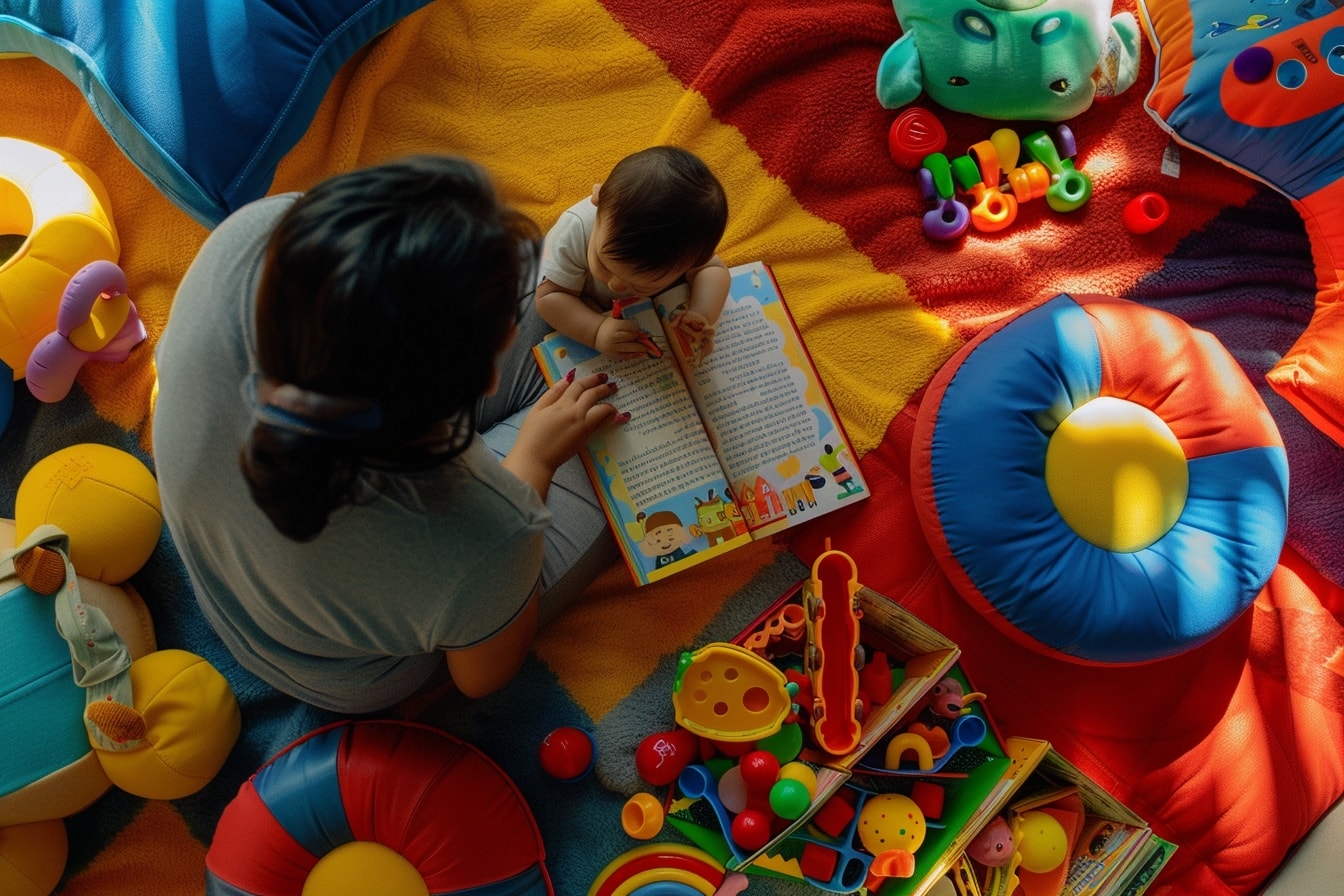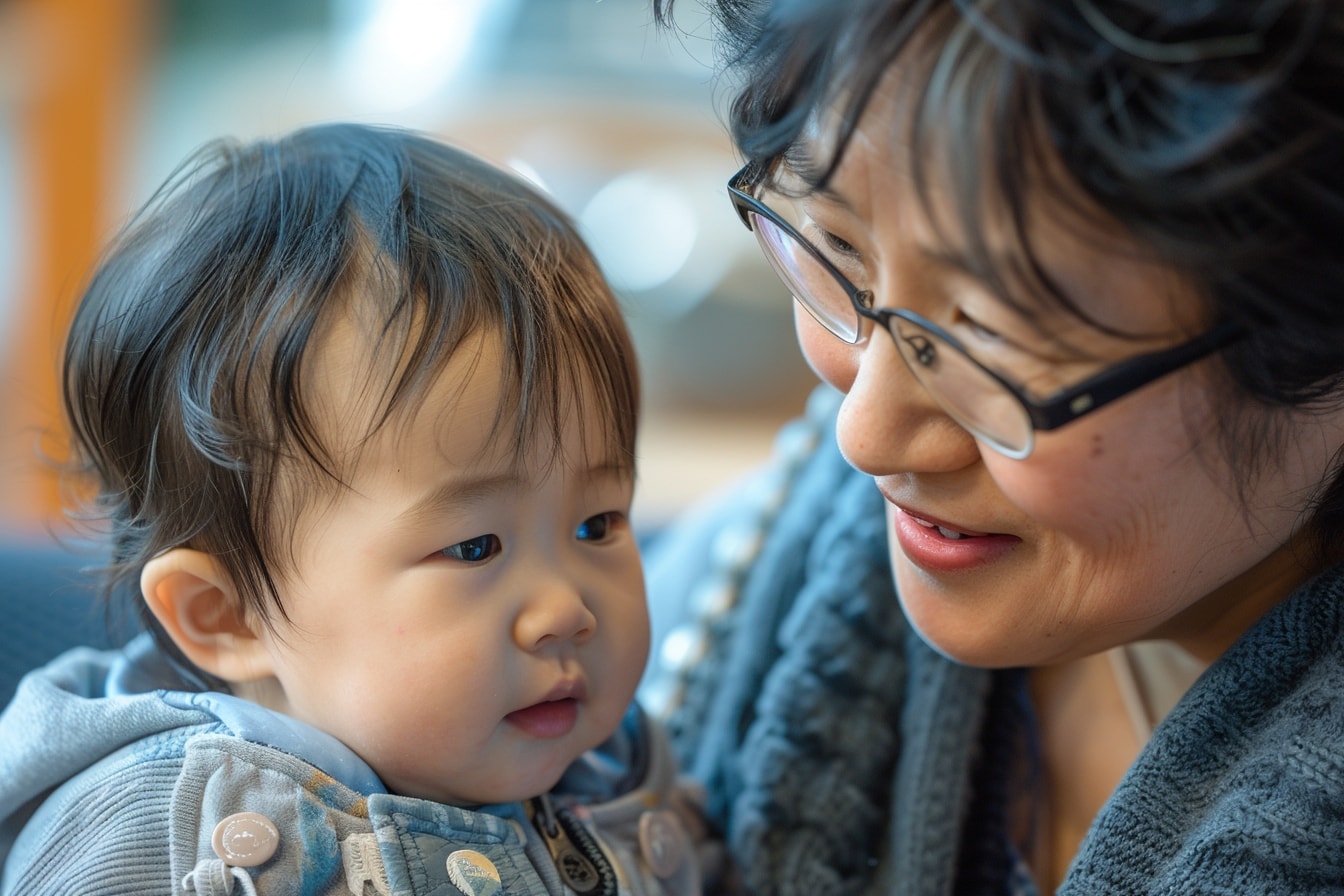Table of Contents
ToggleUnlocking the Power of Language: Fostering Communication in Infants
Picture this—tiny hands reaching out, eyes brimming with curiosity, eager to explore the world around them. As parents, we are not just witnessing growth; we are nurturing it, especially when it comes to language development.
Every coo, every babble, every attempt at forming words is a testament to the incredible journey our infants embark on as they navigate the complexities of communication. It’s not just about learning to speak; it’s about understanding, connecting, and expressing oneself in a world filled with wonder and possibility.
Language is more than just words strung together; it’s the bridge that connects hearts and minds, fostering bonds that transcend time and space. From the first tentative utterances to the eloquent conversations of adulthood, language shapes our experiences, shapes our relationships, and shapes who we are.
But fostering effective communication in infants is not merely a task; it’s a sacred responsibility—one that requires patience, dedication, and a deep understanding of the profound impact language has on every aspect of a child’s development.
In this article, we embark on a journey of exploration and discovery, delving into practical strategies and insights to empower parents in nurturing the linguistic abilities of their infants. Together, we’ll unlock the power of language, enriching their lives with the vibrant tapestry of Caribbean culture.

Creating a Language-Rich Environment
Language thrives in an environment brimming with conversation, curiosity, and connection. As parents, we have the incredible opportunity to shape this environment and nurture our infants’ linguistic abilities from the very beginning.
Immersive Conversations:
- Engage in conversations with your infant throughout the day, whether it’s during diaper changes, meal times, or playtime. Every interaction is an opportunity for language development.
- Use descriptive language to narrate your actions and surroundings, introducing your infant to new words and concepts. For example, Look at the bright yellow sun shining in the sky!
- Encourage turn-taking in conversations by pausing after you speak, allowing your infant to respond in their own way, whether it’s through babbling, cooing, or gestures.
- Be attentive to your infant’s cues and responses, responding with enthusiasm and encouragement. Smile, nod, and make eye contact to convey warmth and engagement.
Reading as a Ritual:
- Make reading a daily ritual in your infant’s routine, incorporating it into bedtime or naptime rituals to create a sense of comfort and familiarity.
- Choose age-appropriate books with colorful illustrations, engaging textures, and simple language that captivates your infant’s attention.
- Read with expression, using different voices for characters and emphasizing key words and phrases to make the story come alive.
- Encourage active participation by asking open-ended questions about the story, pointing to pictures, and allowing your infant to turn the pages.
By immersing our infants in rich conversations and storytelling experiences, we lay the foundation for a lifelong love of language and learning. Every word spoken, every story shared, strengthens the bond between parent and child, fostering a deep connection that transcends words.

Immersive Conversations
Imagine the magic that unfolds when you engage in conversations with your infant—their eyes light up with curiosity, their tiny hands reaching out as if trying to grasp the very essence of your words. These moments are not just exchanges; they are windows into their budding minds, filled with wonder and potential.
Here are some ways to immerse your infant in rich conversations that spark joy, curiosity, and connection:
- Every Moment Counts: From the moment your infant wakes up to the time they drift off to sleep, every moment is an opportunity for conversation. Describe your actions as you go about your day, from making breakfast to getting dressed, inviting your infant to be part of your world.
- Speak with Intention: Be mindful of the language you use when conversing with your infant. Use clear, simple words and sentences, and maintain a warm, soothing tone to create a nurturing environment. Your words carry immense power—they shape your infant’s understanding of the world and lay the foundation for their language development.
- Follow Their Lead: Pay attention to your infant’s cues and responses during conversations. Notice their expressions, gestures, and vocalizations, and respond with genuine interest and enthusiasm. By following their lead, you validate their efforts to communicate and foster a sense of connection and trust.
- Turn-Taking: Encourage turn-taking in conversations by pausing after you speak, allowing your infant to respond in their own way. This could be through babbling, cooing, or even simple gestures. Acknowledge their efforts with a smile, nod, or gentle touch, reinforcing the joy of communication.
- Make it Interactive: Conversation is a two-way street. Engage your infant in interactive dialogue by asking simple questions and waiting for their response. Even if they’re not yet able to form words, their expressions and gestures speak volumes. Celebrate their attempts to communicate, no matter how small.
Remember, conversations with your infant are not just about transmitting information; they’re about building bonds, fostering curiosity, and nurturing their innate desire to connect with the world around them. So, dive into the magic of conversation, and watch as your infant’s world expands with each word spoken.

Reading as a Ritual
Imagine the cozy scene: you and your little one snuggled together, a colorful book open before you, the soft glow of a lamp casting a warm light. This is not just a moment; it’s a cherished ritual—a time to bond, to explore, and to ignite the imagination through the magic of storytelling.
Here’s how you can turn reading into a cherished ritual in your infant’s life:
- Consistency is Key: Make reading a part of your daily routine, whether it’s in the morning, before naptime, or as part of your bedtime ritual. Consistency creates a sense of comfort and familiarity, making reading a cherished part of your infant’s day.
- Choose Wisely: Select books that are age-appropriate, with colorful illustrations, simple text, and sturdy pages that can withstand eager little hands. Look for books that reflect your infant’s interests and experiences, whether it’s animals, shapes, or everyday activities.
- Make it Interactive: Reading is not a passive activity—it’s an interactive experience that engages all the senses. Encourage your infant to explore the book by pointing to pictures, turning pages, and feeling different textures. Use different voices for characters and sound effects to bring the story to life.
- Follow Their Lead: Pay attention to your infant’s cues during reading time. If they lose interest or become restless, don’t force them to continue. Instead, follow their lead and choose books or activities that capture their attention and spark their curiosity.
- Encourage Exploration: Reading is not just about decoding words; it’s about exploring new worlds and ideas. Encourage your infant to explore beyond the pages of the book—ask open-ended questions, make connections to their own experiences, and encourage imaginative play inspired by the story.
As you embark on this journey of reading together, remember that it’s not just about teaching your infant to read; it’s about fostering a love of learning, nurturing their imagination, and building cherished memories that will last a lifetime. So, snuggle up with your little one, open a book, and let the adventure begin.

Empowering Expression
Communication is more than just words; it’s the gateway to self-expression, connection, and understanding. As parents, we have the incredible opportunity to empower our infants to express themselves confidently and authentically.
Here are some ways to foster empowerment and self-expression in your infant:
- Encourage Babbling: Babbling may sound like nonsensical chatter, but it’s actually a crucial stage in language development. Encourage your infant to babble by responding enthusiastically to their vocalizations, imitating their sounds, and engaging in back-and-forth babbling exchanges. Celebrate their attempts to communicate, no matter how unintelligible they may seem.
- Validate Their Efforts: Every attempt at communication, whether it’s a babble, a gesture, or a facial expression, deserves validation and encouragement. Respond with warmth and enthusiasm to show your infant that their efforts are valued and understood. This validation boosts their confidence and motivates them to continue exploring and experimenting with language.
- Model Communication: Your infant learns by watching and imitating you. Model clear and expressive communication by using simple words and gestures to convey your thoughts and feelings. Label objects, describe actions, and narrate your day-to-day activities to provide your infant with a rich language environment to learn from.
- Embrace Nonverbal Communication: Language goes beyond words—it encompasses gestures, facial expressions, and body language. Encourage your infant to express themselves through nonverbal means by responding sensitively to their cues and signals. Smile, nod, and make eye contact to convey warmth and understanding, fostering a sense of connection and trust.
- Celebrate Milestones: Language development is a journey filled with exciting milestones. Celebrate each new word, gesture, and expression your infant learns, recognizing the progress they’ve made and the effort they’ve put in. This celebration not only boosts their confidence but also reinforces the joy of communication.
By empowering our infants to express themselves confidently and authentically, we lay the foundation for a lifetime of effective communication, meaningful connections, and self-discovery. So, embrace the journey of empowerment, and watch as your infant’s voice grows stronger with each passing day.

Encouraging Babbling
Babbling—it’s the symphony of infancy, the precursor to speech, and a window into your little one’s developing language skills. While it may sound like mere gibberish to the untrained ear, babbling is actually a vital step in your infant’s journey towards effective communication.
Here are some ways to encourage and nurture your infant’s babbling:
- Responsive Interaction: When your infant babbles, respond with enthusiasm and attentiveness. Mirror their sounds and gestures, showing them that you’re listening and engaging with their attempts at communication. This back-and-forth interaction reinforces the joy of communication and encourages further babbling.
- Imitation: Encourage your infant to imitate your sounds and gestures by modeling clear and expressive communication. Use exaggerated facial expressions, playful sounds, and simple words to demonstrate the art of communication. Your infant learns by watching and imitating, so be a positive role model for effective communication.
- Provide Opportunities: Create opportunities for your infant to babble by engaging them in interactive activities and conversations throughout the day. Whether it’s during playtime, mealtime, or bath time, seize every moment to encourage vocalizations and babbling exchanges. The more opportunities your infant has to practice, the stronger their language skills will become.
- Celebrate Efforts: Celebrate your infant’s babbling efforts with praise and encouragement. Let them know that their attempts at communication are valued and understood, regardless of how unintelligible they may seem. By acknowledging their efforts, you boost their confidence and motivation to continue exploring and experimenting with language.
- Expand on Babbling: Build on your infant’s babbling by responding with words and phrases that match their vocalizations. For example, if your infant says ba-ba, you can respond with Yes, that’s your bottle! Do you want some milk? This interactive dialogue helps your infant understand the connection between sounds and meanings, laying the foundation for future language development.
Remember, babbling is not just random noise—it’s your infant’s way of exploring and experimenting with language. By responding with warmth, encouragement, and engagement, you create a supportive environment that empowers your little one to find their voice and express themselves confidently.
As we reach the end of our exploration into the world of language development in infants, it’s clear that communication is not just about words—it’s about connection, understanding, and empowerment. Through immersive conversations, interactive reading rituals, and nurturing environments, we’ve laid the foundation for our little ones to thrive and flourish.
But our journey doesn’t end here. It’s only just begun. As parents, we have the privilege and responsibility to continue nurturing our infants’ language skills, fostering a love of communication that will serve them well throughout their lives.
So, let’s continue to engage our infants in rich conversations, opening up new worlds of discovery and wonder with every word spoken. Let’s make reading a cherished ritual in their lives, igniting their imaginations and fueling their thirst for knowledge.
Let’s empower our infants to express themselves confidently and authentically, celebrating their unique voices and contributions to the world. And let’s celebrate every milestone along the way, recognizing the incredible progress our little ones make with each babble, gesture, and word.
As we embrace the journey of language development, let’s remember that we’re not just teaching our infants to speak—we’re giving them the gift of connection, the power of expression, and the foundation for a lifetime of learning and growth. So, let’s continue to nurture their linguistic abilities with love, patience, and joy, knowing that we’re laying the groundwork for a bright and promising future.
Want to take your knowledge to the next level? Check out these must-read articles:
- From Crawling to Climbing: Encouraging Physical Exploration
- Gardening with Baby: Growing Plants and a Growth Mindset
Organize your baby’s wardrobe with our baby clothes closet organizer products! Our organizers are designed specifically for baby clothes. Get your baby’s clothes neat and tidy with our selection of organizers – shop now!
Step into Sue Brown's World of Baby Care, where you'll find a treasure trove of knowledge and wisdom waiting to be explored. Sue's dedication to providing accurate and up-to-date information on baby care shines through in every article, blog post, and resource she shares. From newborn essentials to sleep training tips, breastfeeding advice to nurturing your baby's development, Sue covers a wide range of topics that are essential for every parent to know. Her warm and compassionate approach creates a sense of community and reassurance, making her website a safe haven for parents seeking guidance and support. Let Sue Brown be your partner in this beautiful journey of parenthood, as she empowers you to create a loving, nurturing, and thriving environment for your little one.
- The Science of Peek-a-Boo: Why Simple Games Matter - October 3, 2025
- Second-hand Baby Gear Safety Guide - October 2, 2025
- The Division of Labor: Creating Equitable Parenting Partnerships - September 29, 2025
Other Great Posts:
- How to use games and activities to promote a growth mindset in your baby, such as puzzles, building blocks, and memory cards
- Positive Reinforcement in Babyhood: Encouraging a CanDo Attitude
- The Science of Sleep: How Rest Supports Baby’s Brain Development
- Music and Movement: Enhancing Cognitive Growth Through Rhythm



